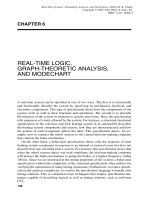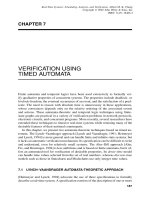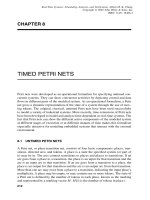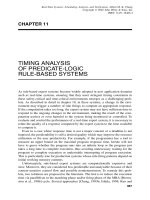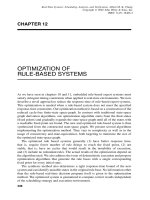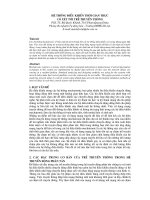Thời gian thực - hệ thống P7
Bạn đang xem bản rút gọn của tài liệu. Xem và tải ngay bản đầy đủ của tài liệu tại đây (192.27 KB, 25 trang )
CHAPTER 7
VERIFICATION USING
TIMED AUTOMATA
Finite automata and temporal logics have been used extensively to formally ver-
ify qualitative properties of concurrent systems. The properties include deadlock- or
livelock-freedom, the eventual occurrence of an event, and the satisfaction of a pred-
icate. The need to reason with absolute time is unnecessary in these applications,
whose correctness depends only on the relative ordering of the associated events
and actions. These automata-theoretic and temporal logic techniques using finite-
state graphs are practical in a variety of verification problems in network protocols,
electronic circuits, and concurrent programs. More recently, several researchers have
extended these techniques to timed or real-time systems while retaining many of the
desirable features of their untimed counterparts.
In this chapter, we present two automata-theoretic techniques based on timed au-
tomata. The Lynch–Vaandrager approach [Lynch and Vaandrager, 1991; Heitmeyer
and Lynch, 1994] is more general and can handle finite and infinite state systems, but
it lacks an automatic verification mechanism. Its specification can be difficult to write
and understand, even for relatively small systems. The Alur–Dill approach [Alur,
Fix, and Henzinger, 1994] is less ambitious and is based on finite automata, but it of-
fers an automated tool for verification of desirable properties. Its dense-time model
can handle time values selected from the set of real numbers, whereas discrete-time
models such as those in Statecharts and Modecharts use only integer time values.
7.1 LYNCH–VAANDRAGER AUTOMATA-THEORETIC APPROACH
[Heitmeyer and Lynch, 1994] advocate the use of three specifications to formally
describe a real-time system. A specification consists of the description of one or more
187
Real-Time Systems: Scheduling, Analysis, and Verification. Albert M. K. Cheng
Copyright
¶
2002 John Wiley & Sons, Inc.
ISBN: 0-471-18406-3
188
VERIFICATION USING TIMED AUTOMATA
timed automata. First, an axiomatic specification specifies the system in a descriptive,
axiomatic style without showing how it operates. Then, an operational specification
describes the operation of the system. A formal proof is required to show that the
operational specification implements the axiomatic specification.
There are several ways to construct this proof. [Lynch and Attiya, 1992; Lynch
and Vaandrager, 1991] have used assertional techniques for untimed, concurrent,
and distributed systems, and thus propose adapting these techniques to verify tim-
ing properties of real-time systems. In particular, the method of simulations is used
to establish the relationships (such as implementation) between two specifications
described by two corresponding timed automata. Here, the concept of simulations
includes special cases such as refinement mappings, backward and forward simula-
tions,andhistory and prophecy mapping.
Several definitions exist for a general timed automaton. One variation proposed
by Lynch and Vaandrager is as follows [Lynch and Vaandrager, 1991].
Timed Automaton: Formally, a timed automaton A is a general labeled transition
system with four components:
states(A) is a set of states.
start(A) is a nonempty set of start states.
acts(A) is a set of actions. Actions can be internal or external. Internal actions are
within the system. External actions include visible actions (which can be input or
output actions) and special time-passage actions v(t),wheret is a positive real
number.
steps(A) is a set of steps (usually known as transitions in other definitions of
automata).
The number of states can be finite or infinite. To improve readability, the notation
s
π
−→
A
s
is used instead of (s,π,s
) ∈ steps(A),whereA is a timed automaton. The
subscript A is often omitted when no ambiguity exists.
7.1.1 Timed Executions
Having defined the concept of a timed automaton, we next consider its behavior by
observing its execution from one point in time to another. A timed execution is a se-
quence of internal, visible, and time-passage actions, connected by their intervening
states, and augmented with the notion of trajectories for each time-passage action. A
trajectory indicates the state changes during time-passage steps. To formally define
a time execution, we first define the notion of a timed execution fragment.
Timed Execution: A timed execution fragment is a finite or infinite alternating se-
quence
α = ω
0
π
1
ω
1
π
2
ω
2
...,
LYNCH–VAANDRAGER AUTOMATA-THEORETIC APPROACH
189
where (1) each ω
i
is a trajectory and each π
i
is a non-time-passage action, and
(2) each π
i+1
connects the final state s of the preceding trajectory ω
i
with the initial
state s
of the succeeding trajectory ω
i+1
, that is, s
π
i+1
−→ s
.
If the first state of the first trajectory, ω
0
, of a timed execution fragment is a start
state, then this fragment is a timed execution.
A state of a timed automaton A is reachable if it is the final state of the final
trajectory in some finite-timed execution of A.Atime of occurrence is associated
with each instance of a state or action in a timed execution. This is done by summing
all the preceding time-passage values. Note that this notion of time of occurrence is
similar to that of the occurrence in real-time logic (RTL).
Given a timed automaton A, of practical interest is the set atexecs(A) of admis-
sible timed executions in which the total amount of time passage is ∞. Next, we
define timed traces to represent the visible behavior of timed automata for solving
verification problems.
7.1.2 Timed Traces
A timed trace of any timed execution is the sequence of visible events that occur in
the timed execution, paired with their times of occurrence. This sequence has the
form
(π
1
, t
1
), (π
2
, t
2
), (π
3
, t
3
),...,
where the πs are non-time-passage actions and the ts are non-negative real-valued
times.
The notation ttrace(α) denotes the timed trace of the timed execution α. The timed
traces obtained from all the admissible timed executions of a timed automaton A
constitute the set attraces(A) of admissible timed traces of A.
Example. Consider a traffic semaphore with three light signals. Initially, there is no
light when the system is off. Once it is turned on at time 0, the event turn
green
makes the green light turn on. Next, the event turn
yellow, occurring 20 s later, turns
the green light off and then the yellow light on. Next, the turn
red event occurring 5 s
later turns the yellow light off and then the red light on. Next, the event turn
green,
occurring 15 s later, turns the red light off and then the green light on. This sequence
is repeated infinitely often. The timed trace of this timed execution is
(turn
green, 0), (turn yellow, 20), (turn red, 25), (turn green, 40),....
Operations on automata exist that allow the definitions of complex automata by
combining simpler automata. These operations include projection and parallel com-
position.
190
VERIFICATION USING TIMED AUTOMATA
7.1.3 Composition of Timed Automata
To model a complex system, we need to combine several automata representing dif-
ferent parts of the system through composition. Two timed automata A and B are
compatible iff they have no common output actions and the internal actions of A are
different from those of B. Then the composition of A and B, written as A × B, is the
timed automaton with:
states(A × B) = states( A) × states(B)
start(A × B) = start( A) × start(B)
acts(A × B) = acts(A) ∪ acts(B).
Step (s
A
, s
B
)
π
−→
A×B
(s
A
, s
B
) exists iff s
A
π
−→
A
s
A
if π ∈ acts(A),else
s
A
= s
A
,ands
B
π
−→
B
s
B
if π ∈ acts(B),elses
B
= s
B
.
This means that A and B can execute jointly on a common input or time-passage
action, or on an output of one that is an input of the other.
7.1.4 MMT Automata
The above definition of a timed automaton is very general. To allow more efficient
verification via simulations, a more specialized automaton is introduced. A Merritt–
Modugno–Tuttle (MMT) automaton [Merritt, Modugno, and Tuttle, 1991] is an I/O
automaton augmented with upper and lower bounds on time between specific ac-
tions. The MMT automaton model can be used to represent many types of timed
automata. An I/O automaton is a labeled transition system for representing an un-
timed asynchronous system. Its internal and output actions are grouped into tasks.
I/O Automaton: An I/O automaton A has the following components:
states(A) is a set of states.
start(A) is a nonempty subset of start states.
acts(A) is a set of actions. Actions can be internal or external. External actions
can be input or output actions.
steps(A) is a set of steps (usually known as transitions in other publications). This
is a subset of states( A) × acts( A) × states A).
part(A) is a partition of the locally controlled (internal and output) actions into at
most countably many equivalence classes.
Note that the definition of a basic timed automaton is basically that of an I/O
automaton extended with the notion of time for steps(A). To define an MMT au-
tomaton, [Lynch and Attiya, 1992; Lynch and Vaandrager, 1991] extend the I/O
automaton model with lower and upper time bound information. More precisely,
an MMT automaton is an I/O automaton with only finitely many partition classes;
and for each class C, lower and upper time bounds are defined and denoted lower(C)
LYNCH–VAANDRAGER AUTOMATA-THEORETIC APPROACH
191
and upper(C),where0≤ lower(C)<∞ and 0 < upper(C) ≤∞. In other words,
the lower bounds cannot be infinite and the upper bounds cannot be 0.
Since an MMT automaton can represent the time differences between certain ac-
tions in the modeled system or its component, the execution of the MMT automaton
shows the behavior of the modeled system over time. A timed execution of an MMT
automaton is an alternating sequence of the form s
0
,(π
1
, t
1
), s
1
,..., where the πs
can be input, output, or external actions. For each i , s
i
π
j+1
−→ s
j+1
must hold such that
the successive times are nondecreasing and are required to satisfy the specified lower
and upper time bound requirements.
The points at which the bounds for a class C begin to be measured are called
initial indices. Index i is defined as an initial index for a class C enabled in state s
i
,
and one of the following must hold: i = 0, C is not enabled in s
j−1
,orπ
i
∈ C.
With this definition, the following conditions must hold for every initial index i for
aclassC:
1. If upper =∞, there exists k > i, t
k
≤ t
i
+ upper(C), such that either π
k
∈ C
or C is not enabled in state s
k
.
2. There does not exist k > i, t
k
< t
i
+ lower(C),andπ
k
∈ C.
Condition (1) is the upper bound requirement; an upper bound of ∞ means that
actions in the corresponding class may never occur. Condition (2) is the lower bound
requirement. The condition of admissibility must also hold; that is, if the sequence is
infinite, then the times of actions approach ∞.
7.1.5 Verification Techniques
A problem P can be formulated as a set of finite or infinite sequences of actions
with corresponding times. Then a timed automaton A is said to solve P if all its
admissible timed traces are in P. Since we can express P as the set of admissible
timed traces of another timed automaton B, the concept of admissible timed traces
induces a preorder on timed automata. The notation A ≤ B means that the set of
admissible timed traces of A is a subset of the set of admissible timed traces of B.
Example. The following MMT automaton describes the behavior of the pedals of
a simplified automobile, which has been specified in Statecharts in chapter 4. The
automobile can be in one of three states: stop, move, or slow. The inputs are ap-
ply
accelerator, apply brake,andapply hand brake. The nontrivial time bounds are
speed up: [0, t
speedup
], slow: [0, t
speedup
],andstop: [0, t
speedup
],wheret
speedup
, t
slow
,
and t
stop
are the upper bounds on the time for the car to speed up, slow, and stop, re-
spectively. The state components now, latest(speedup), latest(slow),andlatest(stop)
are also needed to add timing specifications to each state.
As in the Statecharts specification, the MMT automaton shows that (1) the tran-
sition from the state “stop” to the state “speed up” occurs when the accelerator is
applied; (2) the transition from the state “speedup” to the state “slow” occurs when
192
VERIFICATION USING TIMED AUTOMATA
the brake is applied; (3) the transition from the state “slow” to the state “speedup” oc-
curs when the accelerator is applied; and (4) the transitions from the states “speedup”
and “slow” to the state “stop” occur when the hand brake is applied.
Automaton C: car’s pedals system
States:
status ∈ stop, slow, speedup, initially stop
now, a non-negative real, initially 0
Transitions:
apply
accelerator
Precondition:
s.status ∈ stop, slow
Effect:
s
.status = to speedup
s
.latest(speedup) = now + t
speedup
s
.latest(stop) =∞
s
.latest(slow) =∞
apply
brake
Precondition:
s.status = speedup
Effect:
s
.status = to
slow
s
.latest(slow) = now + t
slow
s
.latest(speedup) =∞
s
.latest(stop) =∞
apply
hand brake
Precondition:
s.status ∈ speedup, slow
Effect:
s
.status = stop
s
.latest(stop) = now + t
stop
s
.latest(speedup) =∞
s
.latest(slow) =∞
speedup
Precondition:
s.status = speeding
up
Effect:
s
.status = speedup
s
.latest(speedup) =∞
ALUR–DILL AUTOMATA-THEORETIC APPROACH
193
slow
Precondition:
s.status = slowing
Effect:
s
.status = slow
s
.latest(slow) =∞
stop
Precondition:
s.status = stopping
Effect:
s
.status = stop
s
.latest(stop) =∞
7.1.6 Proving Time Bounds with Simulations
By including lower and upper time bounds on classes of the specification automaton,
the Larch Prover [Garland and Guttag, 1991] has been used to perform simple simu-
lation proofs for verifying timing properties of real-time and distributed systems.
7.2 ALUR–DILL AUTOMATA-THEORETIC APPROACH
To verify that an implementation of a system satisfies the specification of the system,
we first represent or encode the specification as a Buchi automaton A
S
and the imple-
mentation as a Buchi automaton A
I
. Then we check that the implementation meets
the specification iff L( A
I
) ⊆ L( A
S
), or check for the emptiness of L(A
I
)∩ L(A
S
)
C
;
that is, the intersection of the languages accepted by the implementation and the lan-
guages accepted by the complement of the specification (negation of the specifica-
tion) is empty.
Alur and Dill extend timed automata with a finite set of real-valued clocks to
express timing constraints on non-clock variables. Clocks are like timers (or stop-
watches) and thus can be reset (set to time 0). Clock values increase uniformly with
time; that is, at any instant the value of a clock is equal to the time elapsed since
the last time it was reset. Each transition in a timed automaton is labeled, in addition
to the input symbol, with either a clock value assignment or a clock constraint. A
transition with a clock constraint is enabled only if the current values of the clocks
satisfy this timing constraint. We begin the discussion by reviewing untimed traces
and then extend these to timed traces.
7.2.1 Untimed Traces
A trace is a linear sequence of the observable events of a process. In general, each
process has a set of observable events and the behavior of this process can be modeled
by the set of its traces. For example, a traffic light turning green is an event in a traffic
194
VERIFICATION USING TIMED AUTOMATA
light system, as is the opening of a valve in a fuel system. A trace is a linear sequence
of sets of events in the Alur–Dill model. A trace and a process are defined formally
as follows.
Untimed Trace: Given a set E of events, an untimed trace or simply a trace
ρ =
ρ
1
ρ
2
ρ
3
···is an infinite word over the set of nonempty subsets of E.
A word is also known as a string in descriptions of automata and languages (chap-
ter 2).
Untimed Process: An untimed process is a pair (E, S) where E is the set of the
observable events of the process and S is the set of the possible traces of the process.
Example. Consider a traffic semaphore with three light signals. Initially the green
light is on. Next, the green light turns off and then the yellow light turns on. Next, the
yellow light turns off and then the red light turns on. Next, the red light turns off and
then the green light turns on. This sequence is repeated infinitely often. By treating
green, yellow,andred as events, the only possible trace is:
ρ
P
={green}, {yellow}, {red}, {green}, {yellow}, {red},....
Keeping the notations simple by removing the set symbols, {}, this infinite sequence
is denoted as
green yellow red green yellow red ··· = (green yellow red)
ω
.
Process P is denoted by ({green,yellow,red},(green yellow red)
ω
).
Operations on processes exist that allow the definitions of complex processes by
combining simpler processes. These operations include projection and parallel com-
position.
7.2.2 Timed Traces
In the Alur–Dill model, a real-valued time is associated with each symbol in a word
to form a timed word.
Time Sequence: A time sequence
τ = τ
1
,τ
2
,τ
3
..., where τ
i
is a positive real
number, is an infinite sequence of time values such that (1) the sequence increases
strictly monotonically and (2) for every real number, there is a τ
j
with a larger value.
Note that condition 2 prevents an infinite number of events to occur within a finite
period of time.
ALUR–DILL AUTOMATA-THEORETIC APPROACH
195
Timed Word: A timed word over an alphabet is a pair (ρ, τ) where ρ is an infi-
nite word and
τ is a time sequence.
Timed Language: A timed language over an alphabet is a set of timed words
over .
Using these definitions, if each symbol ρ
i
denotes the occurrence of an event, the
corresponding time value τ
i
indicates the time of occurrence of this event.
Example. A timed language: Given an alphabet with two events, {ok, timeout},
define a timed language L consisting of all timed words (
ρ,τ) such that there is no
ok after time 10.5; that is, the event timeout definitely becomes true at time 10.5 but
may be true earlier. Formally, the language is:
L ={(
ρ,τ) |∀i ((τ
i
> 10.5) → (ρ
i
= timeout))}.
This concept of a time value associated to an event occurrence is similar to the
time value given by the occurrence function in real-time logic (chapter 6) and the
chronos variable in time ER nets (chapter 8). An occurrence function assigns a
time to the occurrence of an instance of an event. A variable chronos assigns a time-
stamp to the production of a token in a Petri net.
The following Untime operation is a projection of a timed trace (
ρ,τ) on the first
component, the sequence of event occurrences
ρ. This operation effectively deletes
the time values corresponding to the event occurrence symbols and is useful when
we do not need the absolute time values.
Untime Operation: Given a timed language L over an alphabet , Untime(L) is
the ω-language with words
ρ such that (ρ, τ) ∈ L for some time sequence τ .
Example. We apply the Untime operation to the above language L:
Untime(L) = ω-language with words containing only finitely many oks.
Timed Trace: A time trace over a set E of events is a pair (
ρ,τ) where ρ is a
(untimed) trace over the set E and
τ is a time sequence.
Timed Process: A timed process is a pair (E, L) where E is a (finite) set of events
and L is a set of timed traces over the set E.
Example. A timed process: Consider the climate control system example shown
in Figure 2.13 (chapter 2). To simply this example, we focus on the events in the
heater section. Assume that the initial instances of the events occur at fixed times and
that subsequent instances of the corresponding events occur at fixed time intervals.
The event turn
on heater happens 10 s after the event cold occurs, followed by the
196
VERIFICATION USING TIMED AUTOMATA
event comfort 5 s later, followed by the event turn off heater 5 s later, followed by
the event cold 30 s later. Suppose the event cold first occurs at time 0. This process
is represented by a timed process:
P
T
= ({cold,turn on heater,comfort,turn off heater}, {ρ
P
})
and it has a single time trace
ρ
P
= (cold, 0), (turn on heater, 10), (comfort, 15), (turn off heater, 20),
(cold, 50), (turn
on heater, 60), (comfort, 65), (turn off heater, 70),
(cold, 100)...
Again, the Untime operation can be used to delete the time values corresponding to
events.
Untime Operation for a Process: Given a timed process P = (E , L), Untime
[(E, L)] is the untimed process where E is the event set and the trace set with traces
ρ such that for some sequence ρ, (ρ, τ) ∈ L.
Example. Automaton α
1
: Consider again the example of the automatic air condi-
tioning and heating system (Figure 2.13) in chapter 2, which specifies the operations
of a climate control system according to changes to a room temperature. The au-
tomaton representing this system can only specify relative ordering of the events but
cannot specify when these events should occur. Hence, it cannot be used to verify
a timing-dependent climate control system. Now we introduce timing constraints to
the transitions of this automaton, yielding the timed automaton shown in Figure 7.1.
Two clocks (clock variables) are present in the transition table, c
1
and c
2
. Suppose
the automaton starts in state s
0
and reads the input symbol cold, then it takes the tran-
sition (indicating that the room temperature falls below 68
◦
F)andmovestostates
4
.
The clock c
1
is reset (set to 0 by the assignment c
1
:= 0) along this transition. In
S
1
S
3
S
2
(c < 10)?
1
(c < 2)?
1
c := 0
2
c := 0
2
c := 0
1
c := 0
1
(c < 5)?
2
(c < 2)?
2
4
S
5
S
6
S
S
cold
hot
comfort
comfort
turn_off_ac
turn_on_ac
turn_on_heater
turn_off_heater
0
Figure 7.1 Automaton α
1
for automatic air conditioning and heating system.
